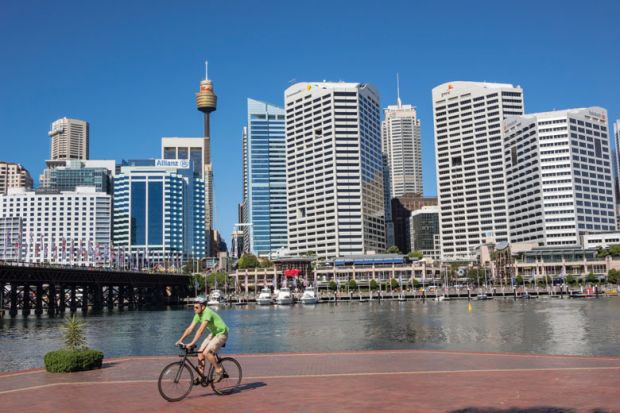Australian universities are being hoodwinked into exchanging serviceable suburban campuses for overpriced high-rise city buildings that students dislike, an architect has warned.
Geoff Hanmer said that a “fad” for vertical campuses in central business districts (CBDs) was driven less by educational objectives than by governments’ enthusiasm for construction.
Writing in The Conversation, he says that the campuses often resulted from city deal funding arrangements where universities, reluctant to reject proposals by state governments that technically own them, agreed to bear disproportionate costs on projects geared more at stimulating economic activity than providing optimum educational facilities.
Universities say that city centre campuses offer access to entertainment, transport, research partnerships and internship opportunities, at a lower cost than refurbishing dated suburban campuses.
But Professor Hanmer told Times Higher Education that teaching facilities cost roughly twice as much per square metre in towers as in low-rise buildings, largely because of the floorspace lost to elevators and escalators. Traditional campuses also gave universities more “flexibility” to adapt their research facilities to emerging fields.
He said that high-rise teaching was impractical because of the time wasted waiting for lifts. Classes have long since been removed from the tower building at the University of Technology Sydney, where he is an honorary professional fellow, with all 27 floors now used for administration.
Professor Hanmer said that of 1.3 million university buildings around the world, just 60 exceeded 11 storeys, with high-rise campuses rare even in high-rise societies. Hong Kong Institute of Science and Technology occupies more than 50 hectares and the National University of Singapore well over 100, in cities that otherwise tended to “pack things on to small sites”.
He said that public transport links were of limited appeal to students accustomed to travelling between campus and workplaces or childcare facilities.
Universities close to city centres tend to score in the bottom half of Australia’s Student Experience Survey. “The evidence is that universities don’t work in CBDs,” Professor Hanmer said.
Edith Cowan University vice-chancellor Steve Chapman disagreed, citing successful inner-city institutions such as London’s Royal Academy of Music and New York’s Columbia Business School. “The great majority of the world’s most vibrant cities have a university at their heart,” he said.
ECU is relinquishing its campus in suburban Mount Lawley for an 11-storey building in Perth’s business district, in a city deal set to cost it A$300 million (£160 million). Canberra will contribute A$245 million and the state government A$150 million, much of it in the form of land from the troubled Perth City Link development project. Professor Hanmer said that the government had been trying to offload it for years.
Professor Chapman said updating Mount Lawley would have cost “significantly more” than ECU’s contribution towards the city campus. He said that students injected life into city centres, where many worked anyway.
“Our students will be connected to industry and business leaders like never before,” he said. “We need to think about…how universities can transform themselves and the cities around them.”
Charles Darwin University, which has borrowed A$152 million to help build an education precinct in the city centre, said that the project would “boost Darwin’s competitiveness” in international education.
Western Sydney University said that its high-rise campuses in “Sydney’s key growth centres” such as Parramatta and Liverpool were “highly regarded by students”. A spokeswoman said that the vertical campuses enabled research partnerships and offered “real-work learning experiences” with nearby businesses.
Register to continue
Why register?
- Registration is free and only takes a moment
- Once registered, you can read 3 articles a month
- Sign up for our newsletter
Subscribe
Or subscribe for unlimited access to:
- Unlimited access to news, views, insights & reviews
- Digital editions
- Digital access to THE’s university and college rankings analysis
Already registered or a current subscriber? Login










